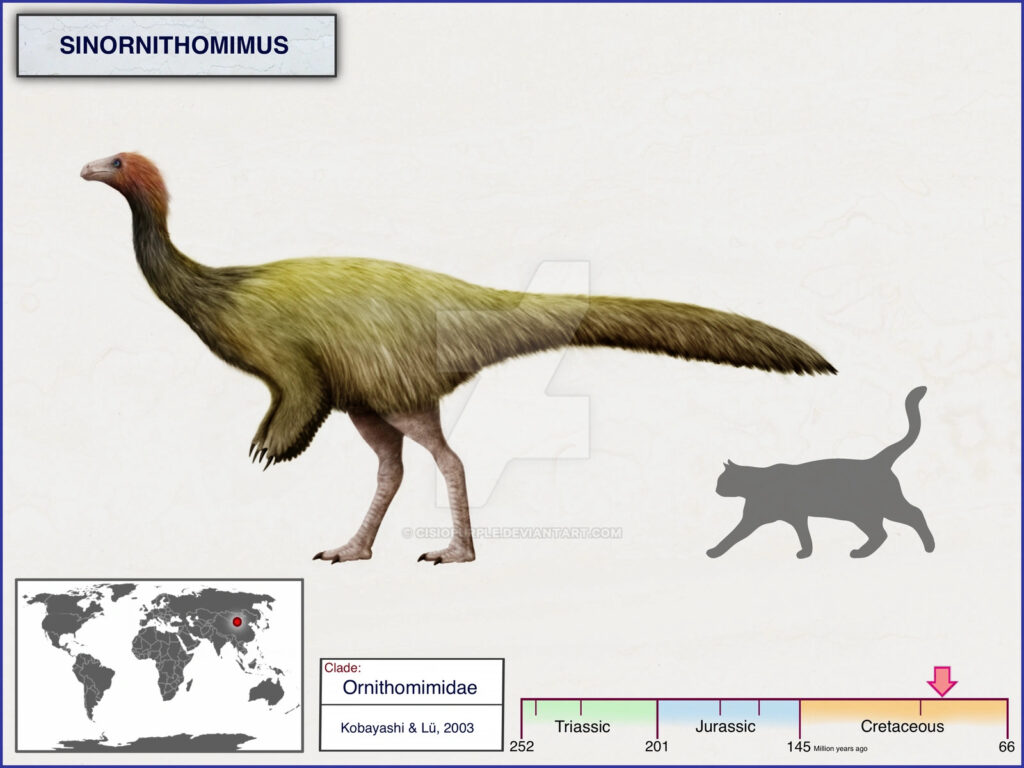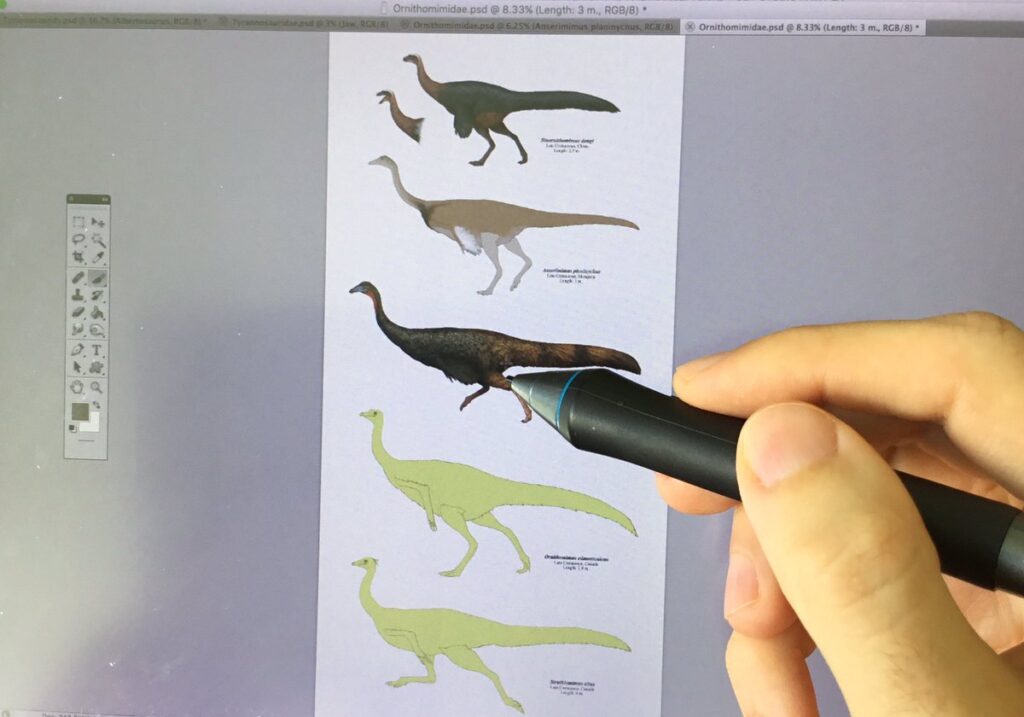Introduction
Sinornithomimus is an intriguing dinosaur species that roamed the Earth millions of years ago. Recent scientific research and discoveries have shed light on its dietary preferences, indicating that it was an omnivorous creature.
In this article, we will discuss the fascinating world of Sinornithomimus, exploring its characteristics, habitat, feeding habits, and the evidence supporting its omnivorous nature.
The Discovery of Sinornithomimus
The discovery of Sinornithomimus in the Yixian Formation of China’s Liaoning Province was a remarkable breakthrough in paleontology. The findings of Sinornithomimus fossils have provided valuable insights into the diversity and evolution of dinosaurs.
Sinornithomimus offers a window into the evolutionary adaptations of dinosaurs. By examining its physical features and comparing them to other dinosaur species, researchers can gain a better understanding of how dinosaurs adapted to their environment and diversified over time.
Key Attributes of Sinornithomimus

| Name | Sinornithomimus |
|---|---|
| Size | Approximately 2.5 to 3 meters (8 to 10 feet) in length |
| Age | Late Cretaceous (approximately 70 to 65 million years ago) |
| Diet | Omnivorous, with a diet that included both plant material and small prey |
| Classification | Kingdom: Animalia, Phylum: Chordata, Class: Sauropsida, Superorder: Dinosauria, Order: Saurischia, Suborder: Theropoda, Family: Ornithomimidae, Genus: Sinornithomimus |
| Habitat | Open plains and forested areas |
| Distribution | Found in Asia, specifically in China and Mongolia |
| Unique Features | Medium-sized ornithomimid, long legs, slender body, toothless beak, and long arms |
| Behavior | Believed to be an agile and omnivorous dinosaur |
| Predators | Shared its ecosystem with various carnivorous dinosaurs |
| Cultural Significance | Provides insights into the diversity and behavior of ornithomimid dinosaurs |
| Fossil Record | Well-preserved fossils discovered in China and Mongolia, providing valuable information about its anatomy and evolutionary relationships |
Physical Features and Classification
Anatomy of Sinornithomimus
Sinornithomimus possessed distinct physical features that set it apart from other dinosaurs. It had a slender and lightweight body, with long and slender limbs that were well-adapted for swift locomotion. Its most notable feature was its beak, which was toothless and resembled the beak of modern birds.
The beak would have been ideal for plucking and manipulating food items, be they plant matter or small prey.
Taxonomic Classification and Relationships
Through detailed examination and comparison of its anatomical characteristics, scientists have classified Sinornithomimus within the larger evolutionary framework of dinosaurs. It belongs to the family Ornithomimidae, a group of theropod dinosaurs known for their bird-like characteristics.
Sinornithomimus shares certain similarities with other ornithomimosaurs, such as its long neck and limbs, suggesting a close evolutionary relationship.
However, its omnivorous nature distinguishes it from its herbivorous relatives. Studying the classification and relationships of Sinornithomimus helps us piece together the evolutionary history and diversity of dinosaurs during the Cretaceous period.
Habitat and Distribution

Ancient Environment of Sinornithomimus
Sinornithomimus inhabited an ancient environment characterized by lush forests, lakes, and river systems during the Early Cretaceous period. The Yixian Formation, where many Sinornithomimus fossils have been found, was a diverse ecosystem with a variety of plant and animal life.
The presence of Sinornithomimus fossils in this formation suggests that it occupied specific habitats within this ancient landscape.
Exploring the Yixian Formation
The Yixian Formation in northeastern China has proven to be a treasure trove for paleontologists, providing a unique window into the Cretaceous period. Excavations in this formation have not only yielded Sinornithomimus fossils but also uncovered a wide range of other dinosaur species, birds, mammals, and plants.
By studying the geology and fossils within the Yixian Formation, scientists gain insights into the ancient environments, ecosystems, and biodiversity of the Early Cretaceous.
Diet and Feeding Behavior
Omnivory in Dinosaurs
The concept of omnivory in dinosaurs challenges the traditional view of them being strictly herbivorous or carnivorous. Sinornithomimus, with its omnivorous diet, represents a fascinating example of dietary versatility among dinosaurs.
Omnivory provided these dinosaurs with the ability to adapt to different food sources, potentially increasing their chances of survival in changing environments and expanding their ecological niche.
Morphological Clues to Dietary Preferences
The anatomical features of Sinornithomimus offer valuable insights into its dietary preferences. Its toothless beak and specialized jaw morphology indicate adaptations for consuming a wide range of food items.
The beak would have allowed it to pluck and manipulate plant matter, while its agile jaw and sharp teeth at the back of the mouth suggest the ability to capture and process small prey.
The combination of these features suggests a flexible feeding strategy, allowing Sinornithomimus to exploit various food resources available in its environment.
Evidence of Omnivory
Traces of Plant Material in Fossils
The presence of plant remains associated with Sinornithomimus fossils provides direct evidence of its consumption of plant material. Fossilized leaf fragments, seeds, and pollen grains have been discovered in the gut contents and coprolites (fossilized feces) of Sinornithomimus.
These findings confirm that plant matter was a significant component of its diet. Analyzing the types of plants preserved in the fossils can provide insights into the specific plant species Sinornithomimus fed upon, helping us understand its ecological role as an herbivore.
Gastroliths: Clues to a Varied Diet
The presence of gastroliths, or gastrolithic stones, in association with Sinornithomimus fossils provides indirect evidence of its omnivorous diet. Gastroliths are stones that dinosaurs swallowed to aid in the digestion of food.
The presence of these stones suggests that Sinornithomimus consumed a variety of food items, including hard plant materials and possibly small pebbles or stones to aid in grinding and processing food in its digestive system.
The discovery of gastroliths provides insights into the diverse dietary strategies employed by this remarkable dinosaur.
Comparison With Other Dinosaurs

Herbivorous Ornithomimosaurs
Comparing Sinornithomimus to other ornithomimosaurs reveals interesting similarities and differences in their feeding adaptations. While many ornithomimosaurs primarily consumed plant matter, Sinornithomimus stood out as an omnivorous species.
By examining the dental morphology, jaw structure, and gut contents of both groups, researchers can gain insights into the evolutionary pathways and adaptations that led to their distinct dietary preferences.
Carnivorous Theropods
Contrasting Sinornithomimus with carnivorous theropods highlights the ecological diversity and niche differentiation among dinosaurs. Unlike its carnivorous counterparts, Sinornithomimus possessed adaptations for consuming both plant matter and animal prey.
By examining the skeletal features, tooth morphology, and hunting strategies of carnivorous theropods, researchers can better understand the unique characteristics that allowed Sinornithomimus to occupy a different dietary niche within its ecosystem.
Unique Ecological Niche of Sinornithomimus
Sinornithomimus as an Ecological Generalist
Sinornithomimus occupied a unique ecological niche as an omnivorous dinosaur. Its ability to consume both plants and small prey likely allowed it to exploit a broader range of food resources compared to strictly herbivorous or carnivorous dinosaurs.
This adaptability may have contributed to its success in the ancient ecosystems, providing it with a competitive advantage in times of resource scarcity or environmental changes.
Interactions With Other Dinosaurs
Understanding the interactions between Sinornithomimus and other dinosaurs within its ecosystem is crucial for reconstructing the dynamics of the ancient environment. As an omnivorous species, Sinornithomimus likely interacted with herbivorous dinosaurs as a potential competitor for plant resources.
It may have also served as prey for larger carnivorous dinosaurs. By studying the fossil record and examining the co-occurrence of different dinosaur species, researchers can piece together the complex web of ecological relationships that shaped the Cretaceous ecosystems.
Importance of Sinornithomimus in Paleontology
Contributions to Understanding Dinosaur Ecology
Sinornithomimus has played a vital role in enhancing our understanding of dinosaur ecology. By studying its feeding adaptations and behavior, scientists have gained valuable insights into the diverse feeding strategies and ecological relationships that existed during the Cretaceous period.
The study of Sinornithomimus has provided evidence of the ecological niches occupied by omnivorous dinosaurs, expanding our knowledge of the roles and interactions of different dinosaur species within ancient ecosystems.
Insights into the Evolution of Feeding Adaptations
The examination of Sinornithomimus’ adaptations and feeding behaviors has shed light on the evolutionary processes that shaped dinosaur feeding adaptations. Comparisons with other dinosaurs have allowed researchers to trace the development of specialized feeding mechanisms and understand the evolutionary transitions from carnivory to herbivory.
Sinornithomimus serves as an important piece in the puzzle of dinosaur evolution, providing clues about the origins and diversification of feeding strategies in theropod dinosaurs.
Significance in the Study of Cretaceous Ecosystems
Sinornithomimus holds great significance in the study of Cretaceous ecosystems. Its presence in the fossil record has enriched our knowledge of the ecological dynamics, species interactions, and biodiversity of the ancient environments in which it lived.
By examining the fossil assemblages and associated flora and fauna, scientists can reconstruct the complex food webs and environmental conditions of the Cretaceous period, contributing to our understanding of past ecosystems and their connections to the present.
The Future of Sinornithomimus Research
Advancements in Paleontological Techniques
Advancements in paleontological techniques offer exciting prospects for future Sinornithomimus research. High-resolution imaging, isotopic analysis, and genetic studies are just a few examples of cutting-edge techniques that can provide new avenues of exploration.
These techniques can yield detailed information about Sinornithomimus’ anatomy, diet, genetic relationships, and even soft tissues. Continued technological advancements will likely unveil further insights into the biology and life history of Sinornithomimus.
Continued Excavations and Discoveries
Ongoing excavations in areas rich in Sinornithomimus fossils hold promise for unearthing new specimens and expanding our knowledge of this fascinating dinosaur. Paleontologists will continue to explore fossil-rich regions, employing careful excavation methods to recover additional bones, trackways, and potential nesting sites.
These ongoing efforts will contribute to a more comprehensive understanding of Sinornithomimus’ biology, behavior, and its role within ancient ecosystems.
Unraveling More Mysteries of Sinornithomimus
While significant progress has been made in understanding Sinornithomimus, many questions remain unanswered. Future research directions may include the study of soft tissues through innovative preservation techniques, the investigation of Sinornithomimus’ reproductive strategies and social behaviors, and the exploration of its response to environmental changes.
By addressing these lingering questions, scientists aim to further illuminate the life and adaptations of Sinornithomimus, enhancing our knowledge of this remarkable dinosaur.
Conclusion
In conclusion, Sinornithomimus stands as an intriguing example of an omnivorous dinosaur based on recent scientific research and discoveries. Through careful examination of its fossils, scientists have determined that Sinornithomimus possessed adaptations for both plant consumption and hunting small prey, representing a unique ecological niche among dinosaurs.
The identification of Sinornithomimus as an omnivorous dinosaur has broader implications for our understanding of dinosaur diversity, behavior, and ecological roles during the Cretaceous period. This discovery challenges traditional notions of dinosaurs as strictly herbivorous or carnivorous, highlighting the versatility and adaptability of these ancient creatures.
By delving into the details of Sinornithomimus’ discovery, physical features, diet, and ecological significance, scientists are uncovering a wealth of knowledge about this extraordinary dinosaur and the world it inhabited.
FAQs
1. How did Sinornithomimus use its beak?
Sinornithomimus likely used its beak to pluck leaves, fruits, and small prey items. The beak’s shape and strength would have enabled it to grasp and manipulate different types of food.
2. Did Sinornithomimus live in groups?
While definitive evidence is lacking, some scientists speculate that Sinornithomimus may have lived in small groups or exhibited social behaviors based on the presence of multiple individuals found together in fossil assemblages.
3. What other dinosaurs lived alongside Sinornithomimus?
Sinornithomimus shared its environment with a variety of other dinosaurs, including other ornithomimosaurs, small theropods, herbivorous dinosaurs like Psittacosaurus, and potentially even larger predators such as tyrannosaurs.
4. How do scientists determine the age of Sinornithomimus fossils?
Scientists use various dating methods, including radiometric dating of the surrounding rock layers, to determine the approximate age of Sinornithomimus fossils. This helps establish the temporal context in which the dinosaur lived.
5. Can we learn more about Sinornithomimus’ behavior from its fossil record?
While the fossil record provides valuable insights into Sinornithomimus’ anatomy and diet, understanding its behavior is more challenging. Scientists rely on anatomical comparisons, trace fossils, and modern analogs to make inferences about its behavior, but many aspects remain speculative.
